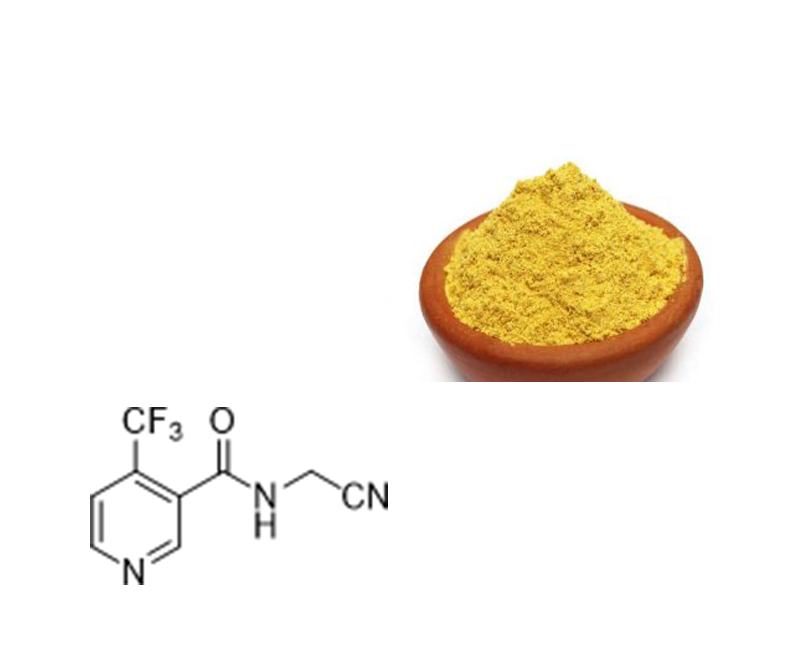Flonicamid Flonicamid Insecticide Manufacturer agrochemical companies pesticide intermediates
CAS: 158062-67-0
Molecular Formula: C9H6F3N3O
Formula Weight: 229.16
Purity: 98.0%
Grade: Industrial Grade
Appearance: Light Yellow Powder

Product Info:
Flonicamid (IKI220; N-cyanomethyl-4-trifluoromethylnicotinamide), is a pyridine organic compound used as an insecticide on aphids, whiteflies, and thrips. It disrupts insect chordotonal organs that can affect hearing, balance, movement to cause cessation of feeding, but the specific target site of the chemical is unknown. It is typically sold as wettable granules mixed with water before spraying.
Teppeki (flonicamid). It is for the control of whiteflies on tomatoes and cucurbits and aphids on peaches, tomatoes, melons and courgettes. The active ingredient was first approved in the US in 2003 and has gained registrations in Europe as Teppeki since 2004.
Flonicamid is very active against aphids, regardless of differences in species, stages and morphs.
This compound inhibited the feeding behavior of aphids within 0.5 h of treatment without noticeable poisoning symptoms such as convulsion, and this antifeeding activity was not recoverable until death.
The nymphs born from adults exposed to flonicamid for 3 h showed high mortality. The effect of flonicamid on the feeding activity of an individual aphid was studied using electronic monitoring of insect feeding behavior (EMIF). Although the treated aphid attached the head of its proboscis to the leaf surface, salivation and sap feeding were strongly inhibited. These results suggest that the main insecticidal mechanism of flonicamid is starvation based on the inhibition of stylet penetration to plant tissues.
The stem medicine method can significantly reduce the use of chemical pesticides and save water resources. Take 10% fluoridintranamide water dispersion granule as an example. According to the recommended dosage and the habit of local farmers, if the cultivation density is 3000 plants / 667m, the dosage of traditional spray method is 35-5og and 45L of water per 667m preparation, and the dosage of stem method is L8g and 9L of water per 667m preparation, a single application can reduce the dosage of preparation by 48.6%-64.0% and save the water consumption by 8O %.
The bee venom issue has pushed neonicotinoids to the forefront of the controversy. Although the future of neonicotinoids remains to be determined by sufficient research data, the use of neonicotinoids has been banned or restricted in many countries and regions around the world. With the long-term and frequent use of these insecticides in the market, the resistance of the stinging and aspirating mouthparts pests to them is on the rise. However, flonicamid has low toxicity to bees and does not have cross-resistance with neonicotinoid insecticides, so it can make up for the market vacancy left by the prohibition and restriction of neonicotinoid insecticides.
Flonicamid is a newly developed high-efficiency insecticide. Flonicamid insecticide has low toxicity to bees, and greatly reduces the use of chemical pesticides, saves water resources, and is effectively promoted and applied.
Chengdu Nudlehealth Biotechnology Limited is a high-tech enterprise dedicated to the development of : high-end pharmaceutical intermediates, health care raw materials, extraction of natural products, chemical raw materials, chemical processes and chemical drugs.
If you want to know more about chemical materials, please click here.
https://www.nudlehealth.com/flonicamid/flonicamid.html
Previous: What are the Uses of Hydroxypropyl Methylcellulose in Building Decoration Materials?
Next: Composite Plant Ester green industrial chemical suppliers green chemical supply
Copyright:@2020-2021
Comments Please sign in or sign up to post.
0
0 of 500 characters used